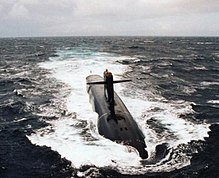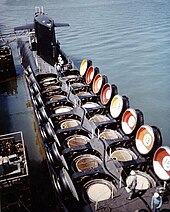From Wikipedia, the free encyclopedia
This article is about submarines carrying nuclear weapons. For submarines powered by nuclear energy, see Nuclear submarine.

The USS George Washington (SSBN-598)–the lead ship of US Navy's first class of Fleet Ballistic Missile Submarines, Nuclear (SSBN). The Washington was the first operational (non-experimental) multi-missile strategic deterrence asset fielded by any navy.

Soviet Delta II class nuclear-powered ballistic missile submarine
Contents
History
| This section does not cite any references or sources. (June 2013) |
The first nation to field ballistic missile submarines was the Soviet Union. Its first successful submarine launch of a ballistic missile was on 16 September 1955 followed in 1956 by modifying the design of several Zulu class diesel powered attack submarines and installing an extra compartment containing two large vertical ballistic missile launch tubes in the middle with the launchers incorporated in the fin/sail. This was followed by a series of specifically designed Golf class units complemented by the nuclear-powered Hotel class, with both classes having three vertical launch tubes incorporated in the sail/fin of each submarine. The initial SS-N-4 ballistic missiles could only be launched with the submarines on the surface but were soon followed by SS-N-5 missiles which were launched with the submarine submerged. The Soviet analogue to the US SSBNs, the Yankee class SSBN with sixteen missiles, began to be built in 1964.
The US Navy fielded the first fleet of its operational missile subs, the George Washington-class submarine in the early 1960s.
Purpose
| This section does not cite any references or sources. (June 2013) |
Ballistic missile submarines equipped with nuclear warheads serve as the third leg of the nuclear triad. The invisibility and mobility of submarines offer both a reliable means of deterrence against an attack (by maintaining the threat of a second strike), and a surprise first-strike capability - particularly given the range of the weapons they carry.
Armament
Main article: Submarine-launched ballistic missile
The extra length and/or beam over attack subs of the same generation is in order to accommodate SLBMs such as the Russian R-29 or the NATO fielded—American manufactured Polaris-II, Poseidon and Trident-II
missiles. Although some early models had to surface to launch their
missiles, modern vessels typically launch while submerged at keel depths
of usually less than 50 meters (164 feet). Missiles are launched
upwards with an initial velocity sufficient for them to pop above the
surface when their rocket motors fire, beginning the characteristic
parabolic climb-from-launch of a ballistic missile.Terminology
SSBN is the US Navy hull classification symbol for a nuclear-powered, ballistic missile-carrying submarine.[1] The SS denotes "Submarine", the B denotes "ballistic missile," and the N denotes "nuclear powered."In US naval slang, ballistic missile submarines are called boomers. In Britain, they are known as bombers.[2] In both cases, submarines operate on a two-crew concept, with two complete crews including two captains, called Gold and Blue in US, Starboard and Port in UK.
The French Navy commissioned her first ballistic missile submarines as SNLE, for Sous-marin Nucléaire Lanceur d'Engin (lit. "nuclear-powered device-launching submarines"). The term applies both to ballistic missile submarines in general (for instance "British SNLE" occurs [3]) and, more technically, as a specific classification of the Redoutable class. The more recent Triomphant class is referred to as SNLE-NG (Nouvelle Génération, "New Generation"). The two crews used to maximise the availability time of the ships are called 'blue' and 'red' crews.
The Soviets called this type of ship RPKSN[4] (lit. "Strategic Purpose Underwater Missile Cruiser"). This designation was applied to the Typhoon class. Another designation used was PLARB[5] which translates as "Nuclear Submarine with Ballistic Missiles". This designation was applied to smaller submarines such as the Delta Class. After a peak in 1984 (following Able Archer 83), Russian SSBN deterrence patrols have declined to the point where there is less than one patrol per sub each year and at best one sub on patrol at any time. Hence the Russians do not use multiple crews per ship.[6]
Active classes
 France
France
 People's Republic of China
People's Republic of China
 Russia
Russia
- Borei class 1 active, 2 are in trials 7 under development in Sevmash.[7][8][9]
- Typhoon class
- Delta III and Delta IV classes
 United Kingdom
United Kingdom
 United States
United States
Classes under development
 India
India
- Arihant class submarine 1 in sea trial 2nd to launch in 2013 total 4 to be constructed .[11][12]
 Russia
Russia
- Borei class submarine 1 active, 2 are in trials 7 under development in Sevmash.[7][8]
Retired classes

The French SNLE Le Redoutable
 /
/ Soviet Union / Russia
Soviet Union / Russia
- Zulu IV class (diesel powered)
- Golf I class (diesel powered)
- Golf II class (diesel powered)
- Hotel I class
- Hotel II class
- Yankee class
- Yankee II class
- Delta I class
- Delta II class
- George Washington class
- Ethan Allen class
- Lafayette class
- James Madison class
- Benjamin Franklin class
- These five classes are collectively referred to as "41 for Freedom".
Accidents
Main article: HMS Vanguard and Le Triomphant submarine collision
On 4 February 2009, the British HMS Vanguard (S28) and the French Le Triomphant collided in the Atlantic.[18][19][20] Vanguard returned to Faslane in Scotland, under her own power,[21] and Triomphant to Île Longue in Brittany.



No comments:
Post a Comment